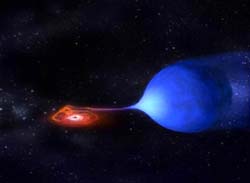This area deals with the fundamental laws and building blocks of nature and how they interact, the properties and the behavior of matter, and research into space and time and their structures.
innovations-report provides in-depth reports and articles on subjects such as astrophysics, laser technologies, nuclear, quantum, particle and solid-state physics, nanotechnologies, planetary research and findings (Mars, Venus) and developments related to the Hubble Telescope.

Scientists at the Canadian Institute for Theoretical Astrophysics (CITA) and NASA have captured unprecedented details of the swirling flow of gas hovering just a few miles from the surface of a neutron star, itself a sphere only about ten miles across. A massive and rare explosion on the surface of this neutron star – pouring out more energy in three hours than the Sun does in 100 years – illuminated the area and allowed the scientists to spy on details of the region never before revealed. T

Since the development of superconducting electronic devices there has been a need to develop a three terminal transistor like device sensitive enough to measure small voltage and current signals typical of those associated with single electron and photon events.
A group of researchers in the Department of Particle & Nuclear Physics at Oxford University has designed a superconducting device with properties analogous to those of a traditional semiconducting transistor. The Quatratran (Quasipar

Thirty years ago the determination of a protein structure required years of effort and typically was sufficient for a Ph.D. thesis. Today, due to advances in synchrotron X-ray sources and detectors, protein crystal structures can be calculated in just hours, “enabling many types of studies that were previously inconceivable,” according to a leading researcher at Cornell University, Ithaca, N.Y.
Sol Gruner, a Cornell physics professor and an expert in designing and building fast, large-area

You would imagine that a 500,000 kilometre long arch of super heated plasma releasing energy equal to the simultaneous explosion of 40 billion Hiroshima atomic bombs would be as easy to “hear” as it is to “see” – but it’s not. Astrophysicists have long thought about using the acoustic waves in these flares to understand more about these gigantic events, that can be dozens of times bigger than the Earth, but have been unable to use effectively up till now. Now researchers at the University of Warwick,

Neutrinos are about the tiniest things in existence, but developing a greater understanding of what they are and how they function is likely to have a huge impact in the next few years.
The subatomic particles, created in the nuclear furnaces of the sun and other stars, have no electrical charge and only recently has it been found that they have any mass at all, yet billions pour through each human body every second with no discernable effect or interaction.
Still, the very slight

After a 7-year interplanetary voyage, NASA’s Cassini spacecraft will reach Saturn this July and begin what promises to be one of the most exciting missions in planetary exploration history.
After years of work, scientists have just completed plans for Cassini’s observations of Saturn’s largest moon, Titan.
“Of course, no battle plan survives contact with the enemy,” said Ralph Lorenz, an assistant research scientist at the University of Arizona’s Lunar and Plan